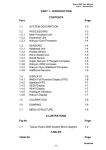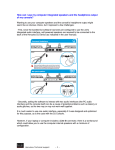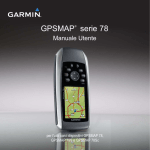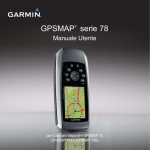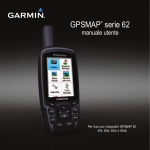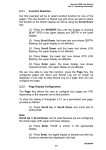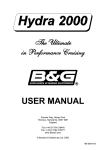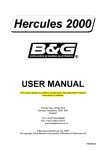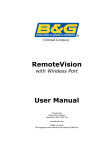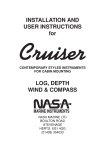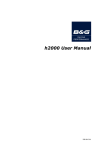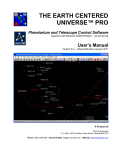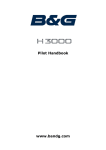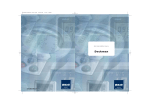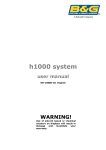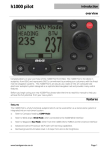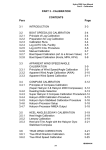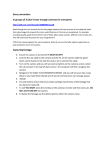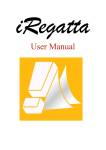Download Herc-Pt 1-Intro_man - Chicago Marine Electronics
Transcript
Hercules 2000 User Manual Part 1 - Introduction PART 1 - INTRODUCTION CONTENTS Para Page 1.1 SYSTEM DESCRIPTION 1-3 1.2 1.2.1 1.2.2 1.2.3 1.2.4 PROCESSORS Main Processor Unit Expansion Unit Performance Processor Halcyon Gyro Processor 1-3 1-3 1-4 1-4 1-5 1.3 1.3.1 1.3.2 1.3.3 1.3.4 1.3.5 1.3.6 1.3.7 SENSORS Masthead Unit Sonic Speed Unit Paddle-Wheel Speed Sensor Super Halcyon 3 Fluxgate Compass Halcyon 2000 Compass Halcyon Gyro Stabilised Compass Depth Sensor 1-6 1-6 1-6 1-6 1-6 1-7 1-7 1-7 1.4 1.4.1 1.4.2 1.4.3 1.4.4 1.4.5 DISPLAYS Full Function Display (FFD) 20/20 Display 40/40 Display Analogue Indicators Halcyon Display 1-8 1-8 1-8 1-8 1-8 1-9 1.5 CALIBRATION 1-9 1.6 DAMPING 1-9 1.7 MENU STRUCTURE 1-10 ILLUSTRATIONS Fig No 1.1 Page Typical Hercules 2000 System Block Diagram 1-2 TABLES Table No 1.1 1.2 Page Function Menu Choices Operational Menu Choices 1-11 1-13 HB-0845-04 1-1 RaceVisionTM TOUCH SCREEN Full Function Displays (FFDs) Hercules 2000 HB-0845-04 1-2 Halcyon Processor Halcyon Processor Halcyon Gyro-Stabilised Compass Hercules 2000 Depth Sensor UltraSonic Speed Sensor Main WD Processor RS232 Fig 1.1 - Typical Hercules 2000 System Block Diagram CD ROM USB Floppy Drive RaceVisionTM CPU Performance Processor NMEA 0183 Hercules 2000 Load Cell Amplifier IR Keyboard/Trackball IR Sensor 20/20 20/20 20/20 Forestay Load Cell B&G 213 Vertical MHU Hercules 2000 User Manual Part 1 - Introduction Hercules 2000 User Manual Part 1 - Introduction PART 1 - INTRODUCTION 1.1 SYSTEM DESCRIPTION The heart of the Hercules 2000 Racing Instrument System is two processor units: the Main and Performance Processors. These two processors integrate raw data from sensors into a set of race winning functions, available on a choice of displays anywhere in the yacht. The modular design allows you to progress from a standard system, adding new units as required. This Manual describes the standard system and then describes how the system can be expanded. The system is connected together by the Fastnet High Speed Communications Network, which handles all the data that travels between two units; the Main Processor and the Performance Processor, and the Full Function Displays (FFDs), 20/20s and Halcyon Displays. These, combined with the wind speed and angle, compass heading, boat speed and depth sensors make up the standard system. A typical system is shown in Fig 1.1, Typical Hercules 2000 System Block Diagram. 1.2 PROCESSORS 1.2.1 Main Processor Unit The Main Processor Unit is responsible for monitoring the data from the sensors, including sensors of both the standard system and the expansion options that may be added. The sensors provide the following functions: Boat Speed/log Depth Apparent Wind Angle Apparent Wind Speed Compass Heading Sea Temperature Air Temperature Ship's Supply Voltage Heel Angle Trim Angle Mast Rotation Barometric Pressure Forestay Load HB-0845-04 1-3 Hercules 2000 User Manual Part 1 - Introduction From this information the Main Processor Unit then calculates the following: Average Boat Speed Velocity Made Good (VMG) Upwind/Downwind Resettable Log Dead Reckoning Course and Distance Leeway Heading Corrected for Leeway (Course) True Wind Speed True Wind Angle True Wind Direction Heading on Opposite Tack Pressure Trend This information, once calculated, is distributed from the Main Processor Unit to the displays via the network. In addition, the Main Processor provides four outputs for analogue indicators. Any one of eight different types of analogue indicator can be used on for each of these outputs. The Main Processor also incorporates a battery backed memory that stores all the calibration, damping and alarm settings whilst the power is OFF; these settings are adjustable from any FFD. 1.2.2 Expansion Unit The Expansion Unit allows a further four analogue indicators and a number of additional sensors to be added to the system. Further details are given in Part 5 - Options. 1.2.3 Performance Processor The Performance Processor adds two components to the system: a polar table to store your yacht's performance data, and interfacing facilities to enable communications between the Hercules 2000 and other electronic devices. The polar tables can be adjusted to suit each individual yacht. Once set up, a range of new functions become available to assist with improved sailing of the boat. HB-0845-04 1-4 Hercules 2000 User Manual Part 1 - Introduction These new functions are: Tacking Performance Reaching Performance Target Boat Speed Optimum Wind Angle Next Leg Wind Predictions Tidal Set and Drift (Not polar related) The functions listed here are explained in detail in Part 2 - Operating Information. The interfaces provided are to both the NMEA and RS232C standards. This allows two-way communication with almost any type of electronic equipment, for instance, position fixers and external computers. Full details on interfacing are given in Part 5 - Options 1.2.4 Halcyon Gyro Processor The Halcyon Gyro Processor Unit is an interface between the Halcyon Gyro Stabilised Compass and the B&G Fastnet Network. It also outputs NMEA heading information for use with other marine instruments and AD10 for use with Radar. The Halcyon Gyro Processor accepts NMEA data from your position fixer for magnetic variation information to allow display and output of True referenced heading. The Halcyon Gyro Processor can also be used as an interface to either output NMEA heading and AD10 from a B&G system compass, or to accept True heading NMEA information from a gyro compass to output and display on a B&G system, along with AD10 and NMEA outputs. Full details are given in Part 3 – Calibration. HB-0845-04 1-5 Hercules 2000 User Manual Part 1 - Introduction 1.3 SENSORS 1.3.1 Masthead Unit The Masthead Unit measures the wind speed and angle at the masthead. A choice of units is available; Standard or Extended Spar. 1.3.2 Sonic Speed Unit The Sonic Speed Unit provides highly accurate and stable boat speed measurement. The Sonic Speed Unit does not rely on mechanical moving parts requiring constant attention for protection from weed etc. The transducers are fitted virtually flush with the hull, creating almost zero drag, and can be painted, faired or anti-fouled over. The Sonic Speed Unit processes the sensor signals for use by the Main Processor, which then generates the boat speed and log functions. 1.3.3 Paddle-Wheel Speed Sensor The Paddle-Wheel Speed Sensor is designed primarily for cruising yachts and consists of a paddle-wheel which protrudes through the hull via a housing. To enable regular cleaning of the paddle-wheel, the housing is provided with a flap valve which closes automatically when the unit is pulled back into the yacht. 1.3.4 Super Halcyon 3 Fluxgate Compass This fluxgate compass sensor is fully gimballed in a bath of oil, ensuring accurate readings at all normal angles of heel and pitch. The unit features automatic deviation correction, thus eliminating the need for expert compass adjustment. HB-0845-04 1-6 Hercules 2000 User Manual Part 1 - Introduction 1.3.5 Halcyon 2000 Compass The Halcyon 2000 Compass is a high performance electronic fluxgate compass for use on both sailing and power craft. It is intended to be connected to Hercules 2000, Hydra 2000 or HS 2000 instrument systems through the B&G Fastnet Network. The Halcyon 2000 Compass has the ability to ‘learn’ the magnetic effect of the vessel on the compass and automatically apply deviation correction. 1.3.6 Halcyon Gyro Stabilised Compass The Halcyon Gyro Stabilised Compass (HGSC) is a high performance, solid state compass that provides the best available heading information through the use of rate gyros to correct for the motion of your yacht. It also provides high accuracy Heel and Trim. It interfaces to Hercules, Hydra and HS 2000 instruments via the Halcyon Gyro Processor that transmits this information to the B&G Fastnet Network. The HGSC is an easily calibrated compass that ‘learns’ the magnetic effects of your vessel on the compass and automatically applies the deviation correction. 1.3.7 Depth Sensor This can either be a removable through hull unit, or moulded in-hull for reduced drag. The depth datum is fully adjustable and can be set to either the waterline, the bottom of the keel or from the transducer. The foregoing sensors combined with the two processor units provide an integrated set of tactical and performance data. Additional sensors provide either single inputs, or improve the accuracy of other functions on the system and are described in Part 5 - Options. HB-0845-04 1-7 Hercules 2000 User Manual Part 1 - Introduction 1.4 DISPLAYS 1.4.1 Full Function Display (FFD) This is the standard system display; every Hercules 2000 must contain at least one FFD. Additional FFDs and other display types, as described in the following paragraphs, are options with which the system can be expanded and made even more powerful to the user. The FFDs name provides an indication that this is more than simply a display. The FFD is a terminal for the whole system, allowing you to control everything from the functions displayed (and those functions displayed at the 20/20s) to the calibration of the system. The FFD simultaneously displays two functions with accompanying descriptive text. Any system function can be called up on any FFD; as many FFDs as you require can be placed on the system - all with full control of the Hercules 2000. Part 2 - Operating Information describes operation of the FFD to control the Hercules 2000. 1.4.2 20/20 Display The Hercules 2000 20/20 is a lightweight, large digit, liquid crystal display which can be configured from any FFD or a remote button to display any system function. The 20/20’s operation is described in Part 5 - Options. 1.4.3 40/40 Display The Hercules 2000 40/40 is a lightweight, large digit, liquid crystal display which can be configured from any FFD or a remote button to display any system function. The 40/40’s operation is described in Part 5 - Options. 1.4.4 Analogue Indicators There are a wide range of analogue indicators available, refer to Part 5 - Options for details. HB-0845-04 1-8 Hercules 2000 User Manual Part 1 - Introduction 1.4.5 Halcyon Display This is a tactical compass display and is described in Part 5 Options. 1.5 CALIBRATION It cannot be over stressed at this stage the importance of calibrating the system properly; in both the initial stages of the installation and operation, and throughout the life of the system. Hercules 2000 calibration is an ongoing process and is something you must be aware of each time you go sailing. This is particularly relevant of the true wind calibration, where constant refining will pay huge dividends in accuracy. To this end the process has been simplified as far as possible, so that all you require for accurate instrument data is some background knowledge together with a few simple techniques. Refer to Part 3 - Calibration. 1.6 DAMPING Another important facility that you need to be constantly aware of is the damping available on certain functions. This allows you to slow down the response of the function when too unstable in rough weather, and similarly to accelerate the function when too slow in flat water. The damping works by averaging the numbers over a time period; the more you increase this time period the smoother the data readings will be, but the longer it will take to see the effect of any change. Similarly the lower the time period the greater the jumps you will see in the numbers, but the response to any change will be quicker; remember, high damping for rough weather, low damping for calm weather. Damping should not be confused with the update rate which is the number of times per second that the function value is sent to the display. The update rate is fixed for all the functions. HB-0845-04 1-9 Hercules 2000 User Manual Part 1 - Introduction 1.7 MENU STRUCTURE The central concept to the operation of the system is the menu structure of the functions, and once this is grasped, operation very quickly becomes familiar. The idea of structured layers of menus is one seen everywhere in modern software, and regular computer users should have a head start. The principle is that at any one level there is a set of choices which you can scroll through (select) until you find the one you want. Having found the correct menu entry, it is then selected - the FFD then displays the first choice in the next level of menu down. Here you once again scroll through the available options until you find and select your choice. In many cases this is as far as you will need to go, i.e. to choose a function for display. To complete some actions such as entering a calibration value, switching on an alarm, and so on, it may be necessary to go to another menu level. The options available for each Function Menu Choice are listed in Table 1.1 - Function Menu Choices. Operational Menu Choices together with the applicable Function Menu are listed in Table 1.2 Operational Menu Choices. Note The functions available to the user are dependent on the range of sensors fitted to the system. Details of the sensors required for each function are fully explained in Part 3 - Operating Information. HB-0845-04 1-10 Hercules 2000 User Manual Part 1 - Introduction Table 1.1 - Function Menu Choices FUNCTION Speed Log Depth Navigate Wind Perform MENU CHOICE Boat Speed Average Speed Velocity Made Good Stored Log Trip Log Depth - Metres Depth – Feet Depth – Fathoms Heading Off Course Dead Reckoning Course Dead Reckoning Distance Course Leeway Tidal Set Tidal Drift Apparent Wind Speed (Kt) True Wind Speed (Kt) Apparent Wind Angle True Wind Angle True Direction Head/Lift Trend Next Leg Apparent Wind Angle Next Leg Apparent Wind Speed Apparent Wind Speed m/s True Wind Speed m/s Tacking Performance Reaching Performance Optimum Wind Angle Polar Speed Layline Distance Heel Angle Next Leg Speed Target Boat Speed Opposite Tack Fore/Aft Trim Mast Angle Wind Angle to the Mast Trim Heel FUNCTION TEXT BOAT SPD AVG SPD VMG STD LOG TRIP LOG DEPTH M DEPTH FT DEPTH FM HEADING OFF CRSE D/R CRSE D/R DIST COURSE LEEWAY TIDE SET TIDE RTE APP W/S TRUE W/S APP W/A TRUE W/A TRUE DIR LIFT/HDR N/L AWA N/L AWS APP W/S MS TRUE W/S MS TACKING REACHING OPT W/A POL SPD LAYLINE HEEL N/L SPD TARG SPEED OPP TACK TRIM MAST ANG W/A MAST TRIM HEEL HB-0845-04 1-11 Hercules 2000 User Manual Part 1 - Introduction Waypoint Motor Temperature Timer Miscellaneous External Brg W/point to W/point Mag. Brg W/point to W/point True Brg to W/point Rhumb Mag. Brg to W/point Rhumb True Brg to W/point Great Circle M Brg to W/point Great Circ True Distance to Waypoint Rhumb Distance to W/point Great Circ Course Over Ground Mag Course Over Ground True Speed Over Ground VMG to Waypoint Estimated Time of Arr to WPT Cross Track Error Battery Voltage Sea Temperature Degrees °C Sea Temperature Degrees °F Air Temperature Degrees °C Air Temperature Degrees °F Timer Linear 1 Linear 2 Linear 3 Linear 4 Barometric Pressure Barometric Pressure Trend Rudder Angle Halcyon Remote 0 to 9 HB-0845-04 1-12 BRG W-W M BRG W-W T BTW RMB M BTW RMB T BTW GC M BTW GC T DTW RMB DTW GC CRSE O/G M CRSE O/G T SPD O/G VMG WPT ETA WPT CROSS TR VOLTS SEA TEMP °C SEA TEMP °F AIR TEMP °C AIR TEMP °F TIMER LINEAR 1 LINEAR 2 LINEAR 3 LINEAR 4 BAROMETR PR TREND RUDDER HALCYON REMOTE 0 TO 9 Hercules 2000 User Manual Part 1 - Introduction Table 1.2 - Operational Menu Choices OPERATION Log Control Timer Control Barometric Pressure PR Trend Control Next Leg Control Alarm Control Sector Alarm Control Damping Control SELECTED FUNCTION(S) Trip Log D/R Course D/R Distance Timer PR Trend N/L AWA N/L AWS BOAT SPD APP W/S DEPTH VOLTS SEA TEMP AIR TEMP HEADING APP W/A BOAT SPD APP W/A APP W/S HEADING TRUE W/A TRUE W/S HEEL TRIM TIDE Calibrate Log (AUTO CAL) BOAT SPD STD LOG Calibrate Log BOAT SPD OPERATIONAL CHOICE RESET RUN FREEZE FREEZE START 0 START 5 START 10 START 15 PERIOD RESET LEG BEAR TIDE ON ALL OFF HI ALARM HI ON HI OFF LO ALARM LO ON LO OFF ALL OFF SECTOR SECT ON SECT OFF Damping Value SINGLE PORT CAL STBD CAL CAL DIST STRT RUN STOP RUN END CAL SINGLE HB-0845-04 1-13 Hercules 2000 User Manual Part 1 - Introduction (MANL CAL) STD LOG Calibrate Log (REF CAL) Calibrate Temp BOAT SPD Calibrate Datum Calibrate App W/A Calibrate App W/S Calibrate Wind All Other Calibrate Functions SEA TEMP °C SEA TEMP °F DEPTH APP W/A APP W/S TRUE W/A TRUE W/S Selected Function HB-0845-04 1-14 PORT CAL STBD CAL Reference CAL OFFSET C DATUM (+/-) MHU ANGL MHU CAL MHU OFFS CORRECTN CAL VAL 1 CAL VAL 2 CAL VAL 3 CAL VAL 4














